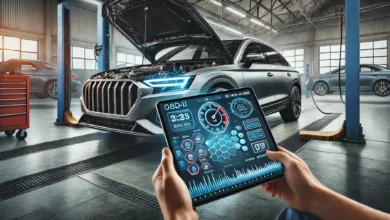Green Tech 2024: Sustainable Innovations for a Better Future
1. Introduction
In 2024, green technology is no longer just a concept discussed in environmental conferences or limited to experimental labs. It has become a vital part of our daily lives, driving sustainable growth and promising a future where technology and nature coexist in harmony. But what exactly is green technology? At its core, green technology refers to the development and use of products, services, and practices that reduce environmental impacts while promoting sustainability.
As climate change becomes an ever-pressing issue, green tech innovations are at the forefront of humanity’s effort to mitigate damage and restore ecological balance. The year 2024 is pivotal because it marks a period of accelerated technological advancements designed to address everything from energy production to waste management, from transportation to urban living. Let’s dive into the key innovations shaping this movement and discover how they’re making our world a better place.
2. The Urgency of Green Technology
The world is facing an environmental crisis, with climate change being one of the most significant challenges humanity has ever encountered. Rising global temperatures, extreme weather events, and the loss of biodiversity are just a few of the symptoms of a planet in distress. As we inch closer to critical environmental tipping points, the need for green technology has never been more urgent.
Governments, industries, and individuals alike are recognizing that technological innovation is essential for meeting sustainability goals. Green technology is the key to reducing carbon emissions, conserving natural resources, and preventing further environmental degradation. The year 2024 is seeing an unprecedented push towards this goal, as the world takes action to reduce its environmental footprint and transition to a more sustainable future.
3. Renewable Energy Revolution
One of the most exciting areas of green technology innovation in 2024 is renewable energy. Traditional energy sources like fossil fuels are not only finite but also responsible for a significant portion of greenhouse gas emissions. Renewable energy, by contrast, is clean, abundant, and increasingly cost-effective.
- Solar Power Innovations: Solar technology has advanced significantly, with new solar panels that are more efficient, flexible, and affordable than ever. Thin-film solar panels, which can be applied to windows and walls, are revolutionizing the way we harvest sunlight. Additionally, researchers are working on solar cells that can generate energy even during cloudy days and at night, using stored heat from the environment.
- Wind Energy Breakthroughs: Wind power continues to grow as a major player in renewable energy. In 2024, floating wind farms are making it possible to harness wind energy in deeper waters, where winds are stronger and more consistent. Micro-turbines, designed for urban environments and small-scale use, are also gaining popularity.
- Tidal and Wave Energy: The ocean has long been seen as an untapped resource for renewable energy. Recent advancements in tidal and wave energy technology are making it a more viable option. These innovations are opening the door to consistent, reliable energy production from the sea.
- Geothermal Energy: Geothermal energy is another renewable source that is gaining traction. By tapping into the Earth’s internal heat, geothermal plants provide a constant, renewable energy source with minimal environmental impact.
4. Energy Storage Innovations
Renewable energy’s biggest challenge has always been storage. The sun doesn’t always shine, and the wind doesn’t always blow, making it difficult to rely solely on these sources for consistent power. Fortunately, 2024 has seen major advancements in energy storage technology.
- Solid-State Batteries: Traditional lithium-ion batteries are being replaced by solid-state alternatives, which offer higher energy densities, longer lifespans, and reduced risk of overheating. This breakthrough could revolutionize both electric vehicles and grid storage.
- Hydrogen as a Clean Fuel: Hydrogen is emerging as a promising clean fuel alternative. When used in fuel cells, hydrogen produces electricity with water as the only byproduct, offering a zero-emission solution for transportation and industrial use.
- Grid-Level Storage Solutions: Large-scale energy storage systems are being implemented to store excess renewable energy and release it when demand is high. These systems are crucial for stabilizing the grid and ensuring a reliable power supply even when renewable sources are unavailable.
5. Sustainable Urban Development
With more than half of the world’s population living in cities, sustainable urban development is essential for reducing humanity’s environmental impact. In 2024, green technology is transforming how cities are designed and built.
- Green Building Designs: Buildings of the future are being designed with sustainability in mind. From energy-efficient materials to smart lighting and ventilation systems, green buildings are reducing energy consumption while improving indoor air quality. Innovations like “living buildings,” which generate more energy than they consume, are becoming increasingly common.
- Smart Cities: The integration of technology and sustainability is epitomized by the rise of smart cities. These urban environments use sensors and data analytics to optimize resource use, reduce waste, and improve the quality of life for residents. From smart grids to automated public transportation, smart cities are leading the way towards a more sustainable future.
- Urban Farming: As cities grow, so does the need for sustainable food production. Vertical farming, rooftop gardens, and urban agriculture are helping cities reduce their carbon footprint by growing food locally. These innovations reduce the need for transportation, minimize waste, and make fresh produce more accessible to urban dwellers.
- Water Conservation: In many parts of the world, water scarcity is a growing concern. Smart water management systems are being deployed to monitor usage, detect leaks, and ensure efficient distribution. Technologies like rainwater harvesting and greywater recycling are also helping cities conserve this precious resource.
6. Electric Vehicles and Transportation
The transportation sector is one of the largest contributors to greenhouse gas emissions, but green technology is driving significant changes in how we get from place to place.
- Evolution of Electric Vehicles (EVs): Electric vehicles are becoming more affordable and accessible. With advancements in battery technology, EVs now offer longer ranges and faster charging times, making them a practical option for more people. In 2024, innovations such as solar-powered vehicles and wireless charging roads are pushing the boundaries of what’s possible in the EV space.
- EV Charging Infrastructure: As the number of electric vehicles grows, so does the need for charging infrastructure. Fast-charging stations are becoming more widespread, and there are even developments in wireless charging, where vehicles can recharge simply by parking over a charging pad.
- Electric Public Transportation: Public transportation systems are also going green. Electric buses, trams, and trains are being adopted by cities around the world, offering a more sustainable alternative to traditional fuel-powered vehicles.
- Sustainable Aviation: The aviation industry is making strides toward sustainability with the development of electric airplanes and biofuels. While still in its early stages, electric flight technology is expected to revolutionize air travel in the coming decades, drastically reducing the sector’s carbon footprint.
- Green Shipping: Maritime transportation is another sector undergoing significant change. Innovations in electric and hybrid ships, as well as wind-assisted propulsion systems, are helping to reduce emissions from the shipping industry, which is responsible for a large portion of global trade-related emissions.
7. Circular Economy and Waste Management
A key aspect of green technology in 2024 is the concept of the circular economy, where products are designed to be reused, refurbished, or recycled, minimizing waste and resource consumption.
- Closed-Loop Manufacturing: In a circular economy, products are created with the intention of being broken down and reused at the end of their life cycle. This closed-loop manufacturing approach helps reduce the need for new raw materials and minimizes waste.
- Recycling Innovations: Recycling technology has come a long way in recent years. New processes are making it possible to recycle materials that were previously considered non-recyclable, such as certain plastics and textiles. In addition, automated sorting technologies are improving the efficiency of recycling facilities.
- Biodegradable Materials: Researchers are developing new biodegradable materials that break down naturally in the environment. These materials are being used in everything from packaging to construction, helping to reduce the amount of waste that ends up in landfills and oceans.
- Plastic Waste Reduction: The fight against plastic pollution continues, with new technologies aimed at reducing plastic waste and cleaning up the oceans. Biodegradable plastics, plastic-eating microbes, and ocean clean-up initiatives are all playing a role in addressing this global issue.
8. Agricultural and Food Tech Innovations
The way we produce and consume food is undergoing a transformation, with green technology playing a central role in ensuring a sustainable food supply for a growing global population.
- Precision Farming: Precision farming technologies use sensors, drones, and data analytics to optimize crop production, reduce waste, and minimize the use of water and chemicals. By tailoring farming practices to the specific needs of each plant, farmers can increase yields while reducing their environmental impact.
- Sustainable Food Production: Innovations in vertical farming, aquaponics, and hydroponics are making it possible to grow food in urban environments, reducing the need for transportation and lowering carbon emissions. These methods also use significantly less water and land than traditional farming.
- Meat Alternatives: The rise of plant-based and lab-grown meats is helping to reduce the environmental impact of livestock farming, which is a major contributor to greenhouse gas emissions and deforestation. These alternatives offer a more sustainable way to meet the world’s growing demand for protein.
- Reducing Food Waste: Green tech is also helping to reduce food waste, which is a major contributor to greenhouse gas emissions. Innovations in food storage, preservation, and supply chain management are making it easier to reduce waste at every stage of the food system.
9. Water Purification and Conservation Technologies
Access to clean, safe water is a growing concern for many parts of the world, but green technology is offering solutions.
- Desalination Technology: Desalination, the process of removing salt from seawater to make it drinkable, has traditionally been energy-intensive and expensive. However, recent breakthroughs are making it more efficient and accessible, offering hope for regions facing water scarcity.
- Water Recycling: Water recycling technologies are becoming more advanced, allowing us to purify and reuse wastewater for agriculture, industry, and even drinking. These innovations are critical for conserving water in areas where it is in short supply.
- Smart Irrigation: Agriculture is one of the largest consumers of water, and smart irrigation systems are helping to reduce this usage by applying water only when and where it is needed. These systems use sensors and data analytics to monitor soil moisture and weather conditions, ensuring efficient water use.
10. Carbon Capture and Climate Engineering
As we continue to emit carbon into the atmosphere, finding ways to remove it is becoming increasingly important. Carbon capture and storage (CCS) technologies are playing a key role in this effort.
- Direct Air Capture: One of the most promising developments in carbon capture is direct air capture technology, which removes CO2 directly from the atmosphere. This captured carbon can then be stored underground or used in industrial processes.
- Ocean-Based Carbon Sequestration: The ocean is a natural carbon sink, absorbing vast amounts of CO2. Innovations in ocean-based carbon sequestration aim to enhance this process by promoting the growth of marine life that naturally captures and stores carbon.
- Ethical Considerations: While climate engineering technologies like carbon capture hold great promise, they also raise ethical questions. How should we balance technological intervention with natural solutions? What are the long-term consequences of tampering with the Earth’s climate systems? These are questions that the green tech community continues to explore.
11. Green Computing and IT Innovations
The tech industry has a significant environmental impact, but green technology is helping to reduce the carbon footprint of computing.
- Energy-Efficient Data Centers: Data centers, which power everything from websites to cloud services, consume enormous amounts of energy. Innovations in cooling systems, energy-efficient hardware, and renewable energy integration are helping to make data centers more sustainable.
- Sustainable Software Development: Green computing also extends to software development. By optimizing code and reducing the need for processing power, developers can create software that runs more efficiently, reducing the energy consumption of devices and servers.
- Artificial Intelligence for Sustainability: Artificial intelligence (AI) is being used to optimize everything from energy grids to transportation systems, making it easier to reduce waste and improve efficiency. AI-driven systems can analyze vast amounts of data to identify patterns and make predictions, enabling more sustainable decision-making.
12. The Future of Sustainable Energy Policy
While green technology is essential for creating a sustainable future, policy changes are also necessary to drive widespread adoption.
- Global Policy Shifts: Governments around the world are implementing policies to incentivize the development and adoption of green technologies. From carbon pricing to renewable energy mandates, these policies are helping to create a market for sustainable innovations.
- International Cooperation: Addressing climate change is a global challenge that requires international cooperation. In 2024, countries are working together through initiatives like the Paris Agreement to set targets for reducing emissions and investing in green technology.
- Incentivizing Innovation: Governments can also play a role in driving innovation by providing funding for research and development, offering tax incentives for green technology companies, and creating regulations that encourage sustainability.
13. Challenges Facing Green Tech Adoption
While green technology holds great promise, there are still challenges to overcome.
- Economic Barriers: The initial costs of green technology can be prohibitive for some industries and consumers. However, as these technologies become more widespread, their costs are expected to decrease, making them more accessible.
- Social Resistance: In some cases, resistance to change can slow the adoption of green technologies. This can be due to a lack of awareness, fear of new technology, or concerns about job loss in traditional industries.
- Education and Awareness: One of the most important factors in driving the adoption of green technology is education. People need to understand the benefits of these innovations and how they can be integrated into daily life.
14. The Role of Individuals in the Green Tech Movement
While governments and industries play a significant role in advancing green technology, individuals also have a part to play.
- Adopting Green Technologies: Consumers can reduce their environmental impact by adopting green technologies like energy-efficient appliances, electric vehicles, and renewable energy solutions for their homes.
- Conscious Consumerism: Making environmentally responsible purchasing decisions is another way individuals can contribute to a greener future. By choosing products that are sustainably produced, recyclable, or biodegradable, consumers can support the circular economy.
- Community Initiatives: Local communities can also drive change by organizing sustainability initiatives, such as community gardens, recycling programs, and renewable energy cooperatives.
15. Conclusion
As we look to the future, green technology is providing us with the tools we need to address some of the world’s most pressing environmental challenges. From renewable energy to sustainable transportation, from smart cities to precision farming, the innovations of 2024 are paving the way for a cleaner, more sustainable world.
The road ahead is not without challenges, but with continued investment in green technology and a collective commitment to sustainability, we can build a future where humanity thrives in harmony with the natural world. Together, we can create a better tomorrow, one innovation at a time.


